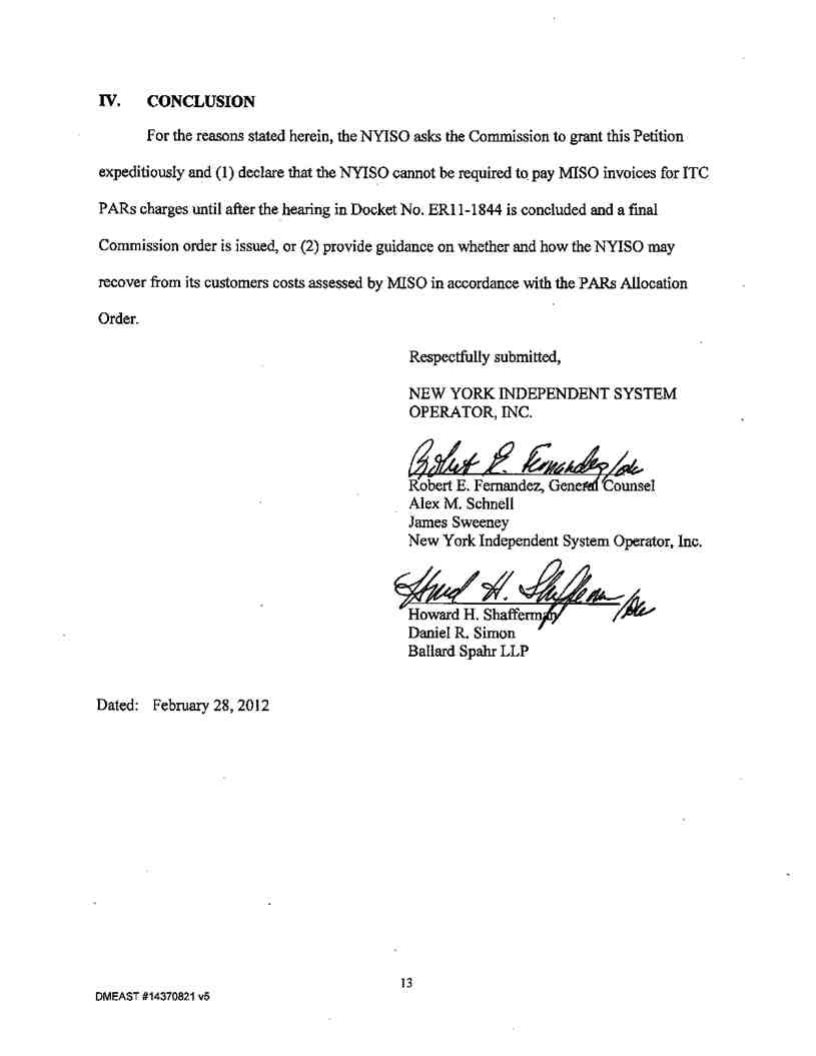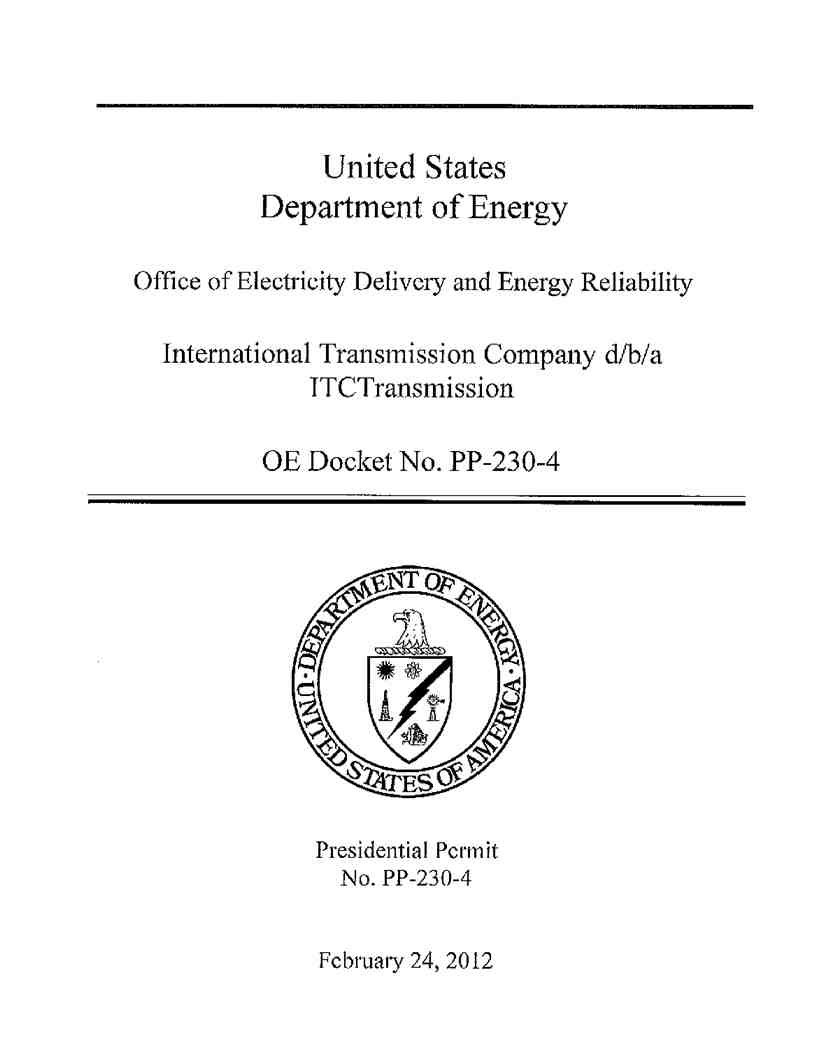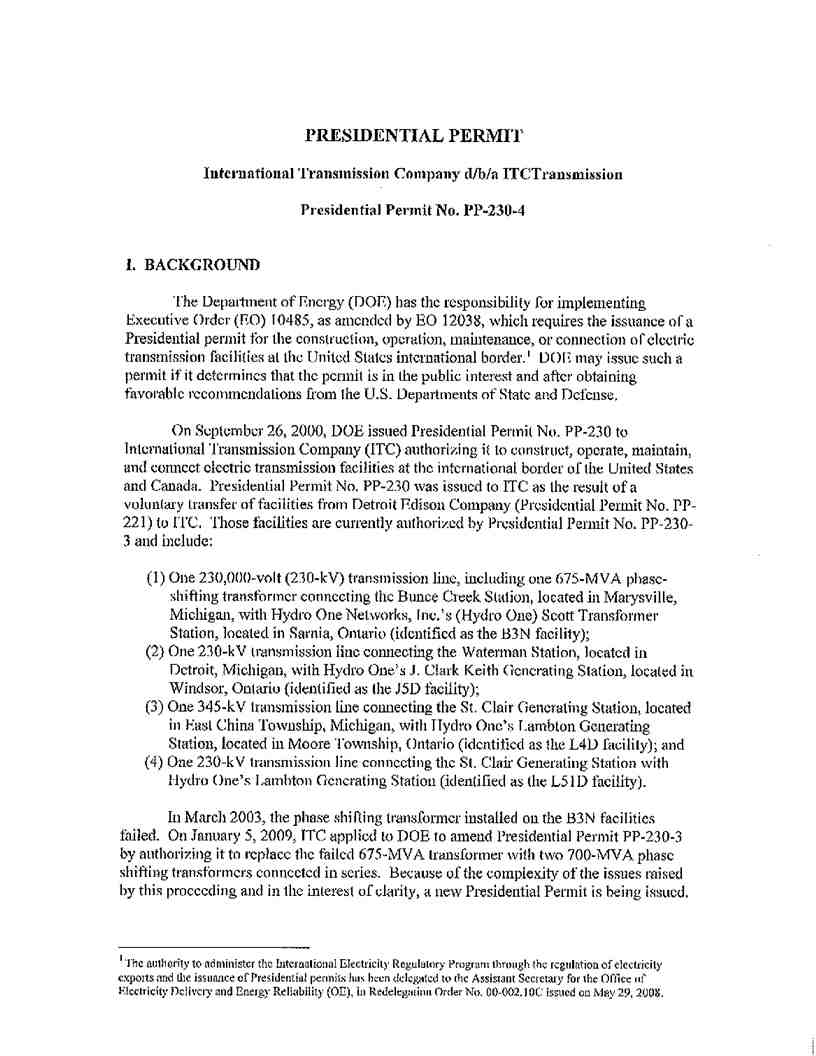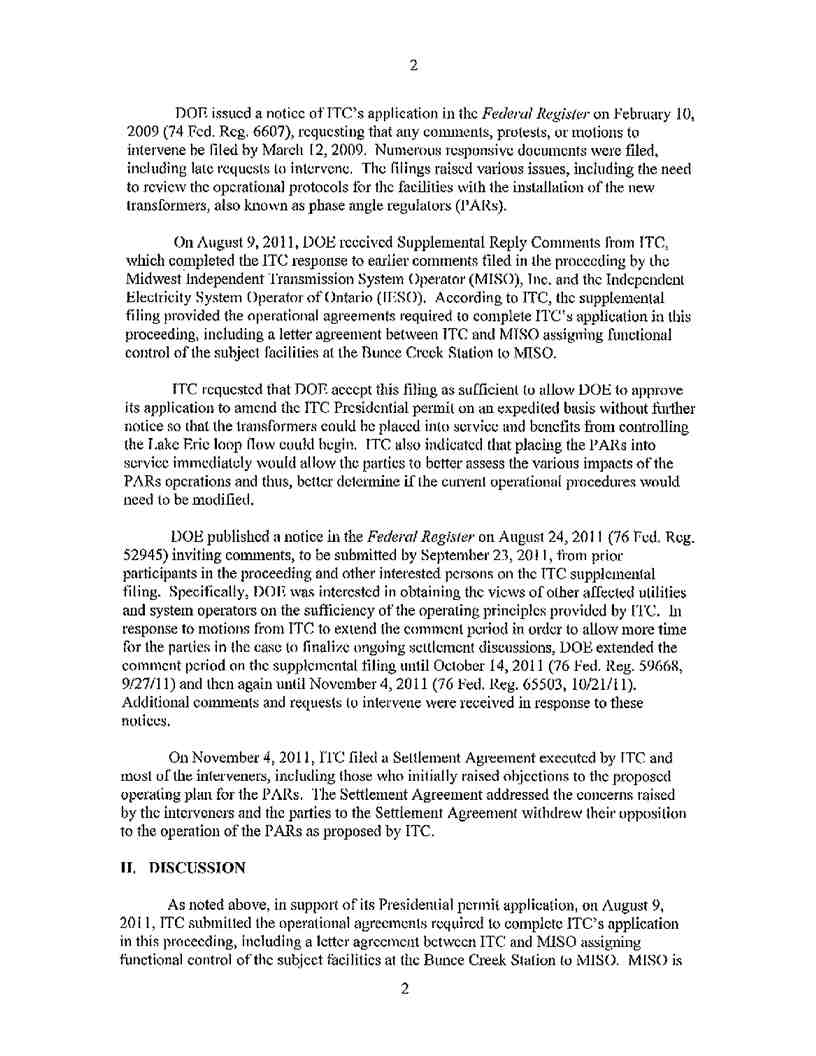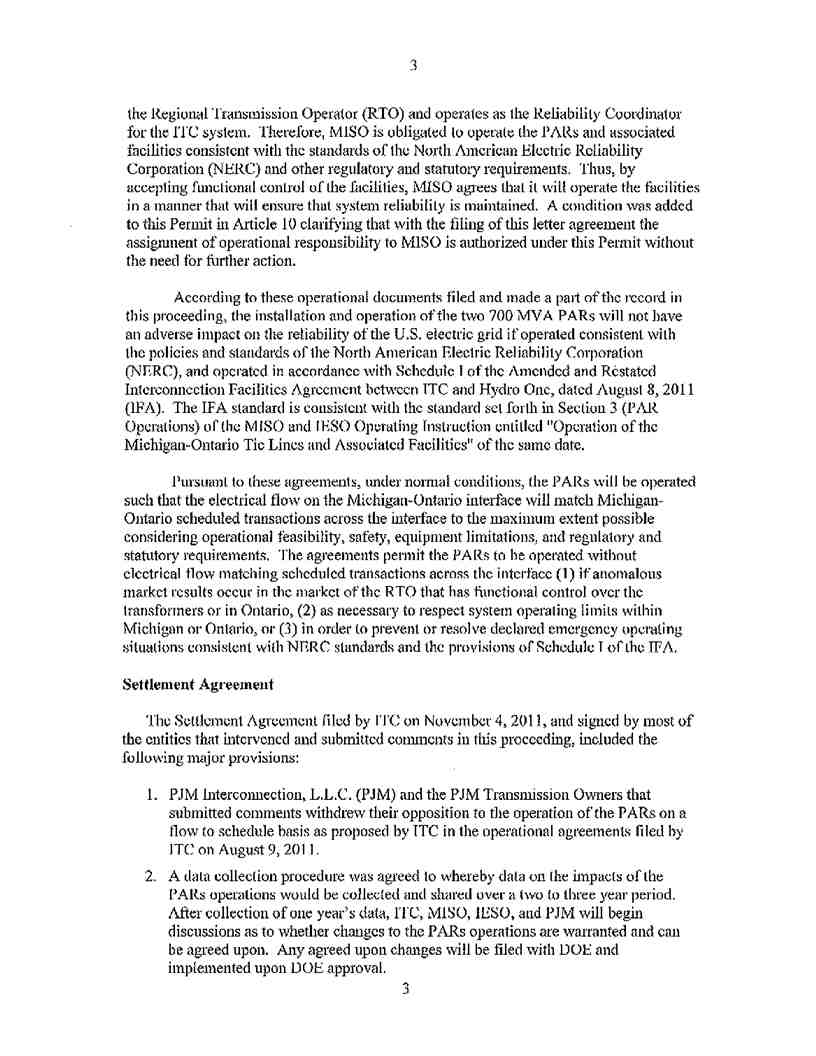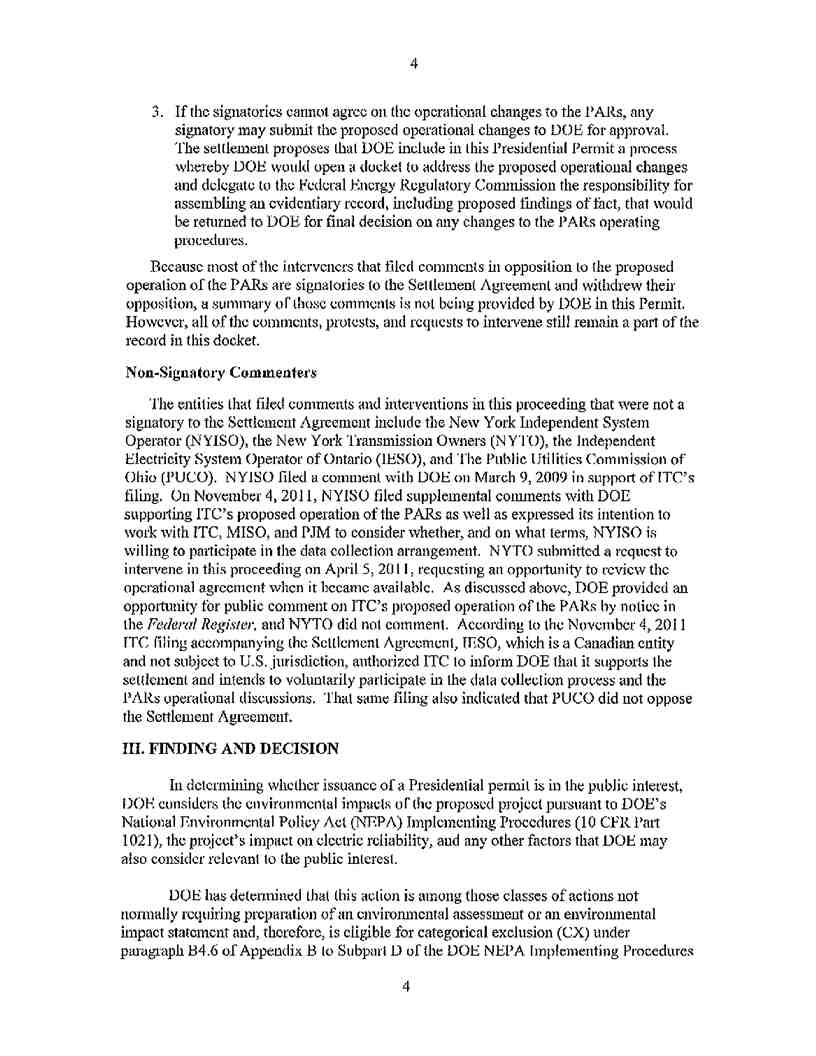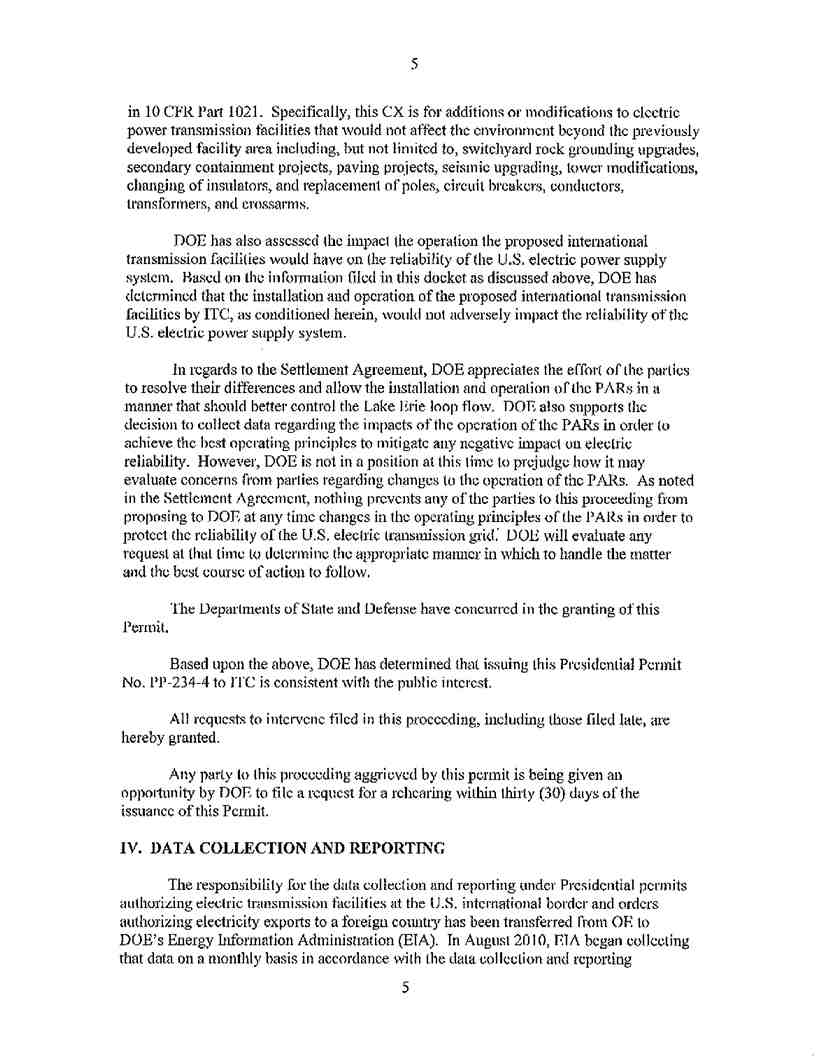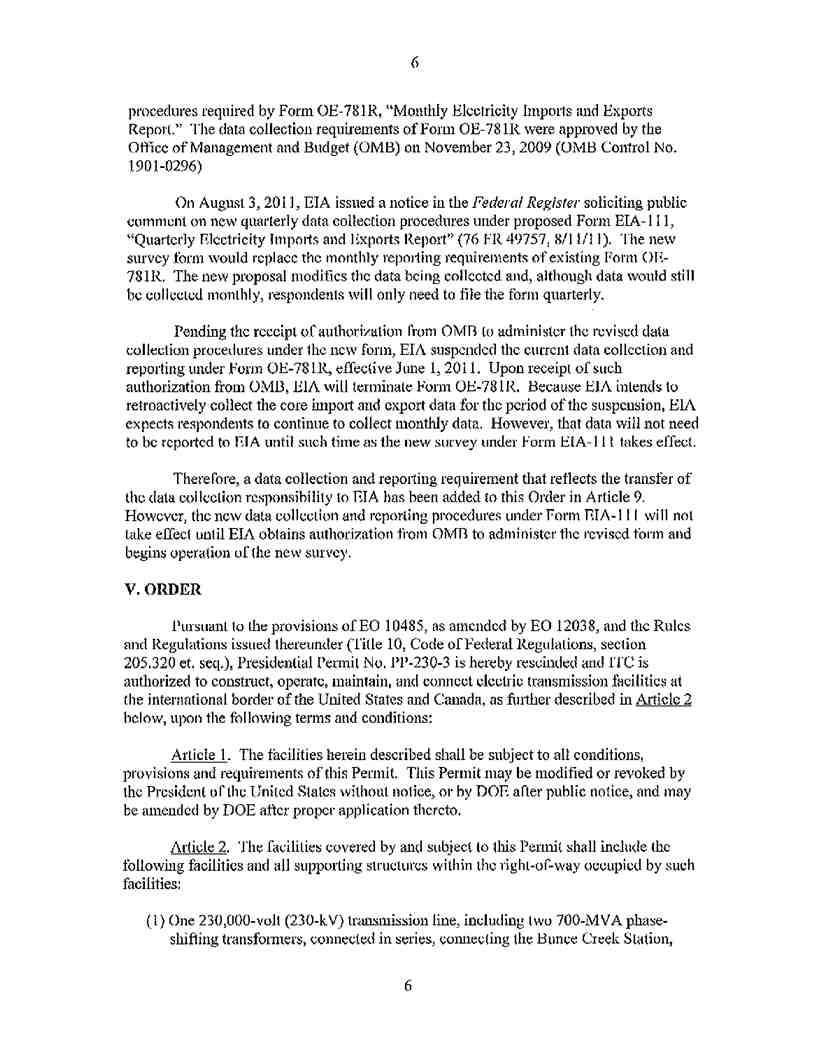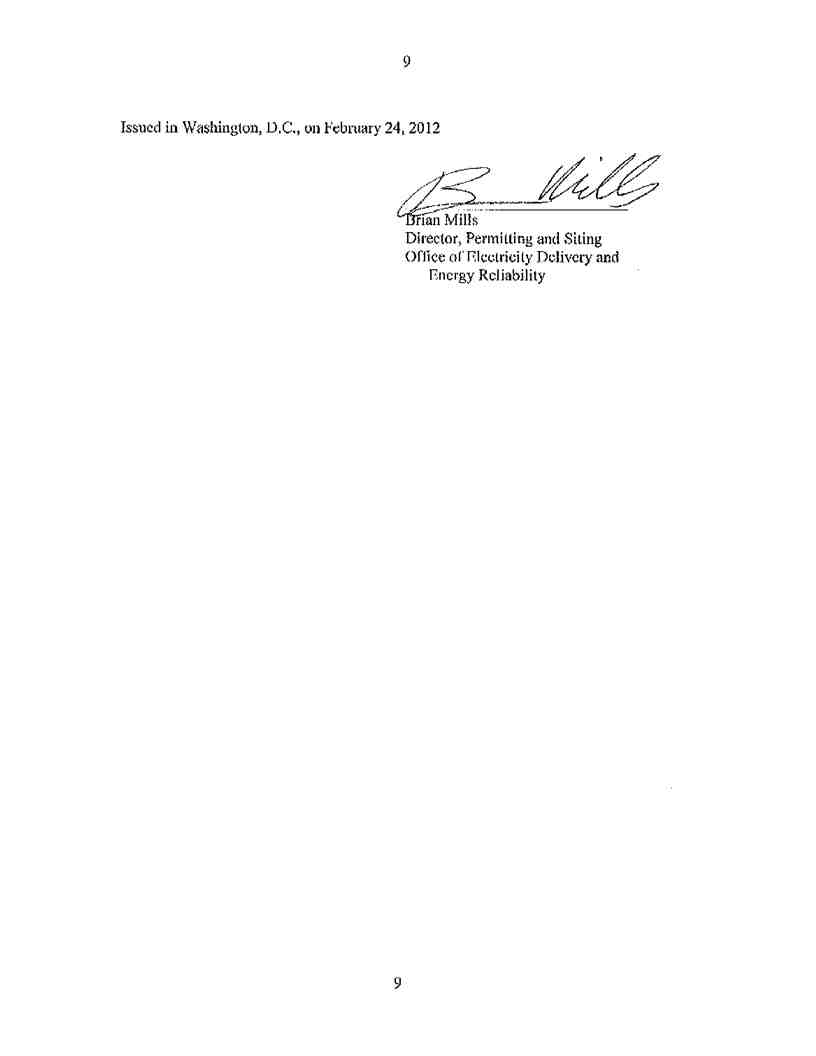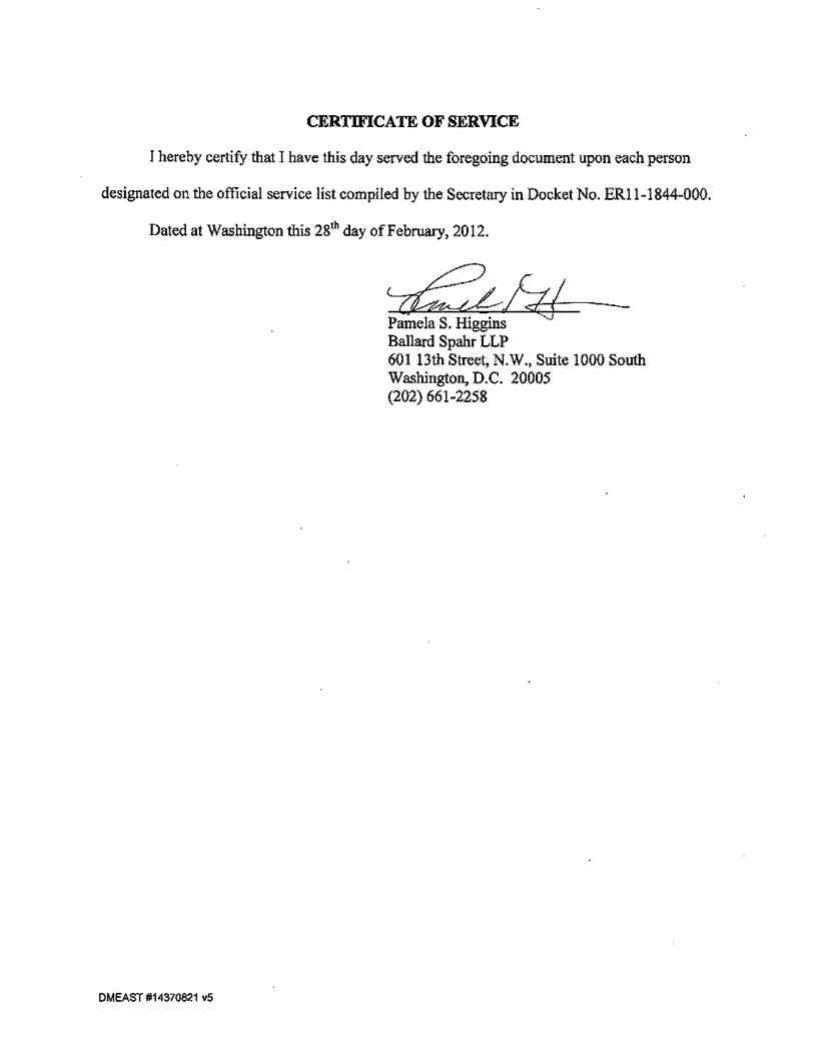UNITED STATES OF AMERICA
BEFORE THE
FEDERAL ENERGY REGULATORY COMMISSION
New York Independent System Operator, Inc. )Docket No. EL12-___-000
PETITION FOR DECLARATORY ORDER OF
NEW YORK INDEPENDENT SYSTEM OPERATOR, INC.
Pursuant to Rule 207 of the Rules of Practice and Procedure of the Federal Energy
Regulatory Commission (the “Commission”), 18 C.F.R. § 385.207 (2011), the New York
Independent System Operator, Inc. (the “NYISO”) submits this petition (the “Petition”)
requesting that the Commission issue a declaratory order to resolve uncertainty regarding how
the NYISO should recover from its customers the costs allocated to it pursuant to the
Commission’s December 30, 2010 order in Midwest Independent System Operator, Inc., 133
FERC ¶ 61,275 (2010) (“PARs Allocation Order”) in Docket No. ER11-1844-000. In addition
to seeking guidance regarding cost recovery mechanisms, the Petition seeks a declaration that the
NYISO cannot be required to pay invoices for charges imposed by the Midwest Independent
Transmission System Operator, Inc. (“MISO”) until after a final Commission order addressing
these charges is issued following the conclusion of the hearing in Docket No. ER11-1844.
The PARs Allocation Order accepted, subject to refund, a joint filing by the MISO and the International Transmission Company (“ITC”) of changes to the MISO tariff (the “MISO
Tariff”) under Section 205 of the Federal Power Act (the “MISO/ITC Filing”). The NYISO has
requested rehearing of the PARs Allocation Order, arguing that Section 205 of the Federal Power
Act does not permit the filing or acceptance of a rate filing where the filing utility does not have
DMEAST #14370821 v5
a contractual or customer relationship with the entities to which the rates will be charged.1 More
recently, on December 13, 2011, the NYISO filed a Motion to Dismiss or for Summary
Disposition or, in the Alternative, Request for Expedited Action on Rehearing Requests in
Docket No. ER11-1844-001 (the “NYISO Motion to Dismiss”). The NYISO Motion to Dismiss
asks the Commission to promptly dismiss the October 20, 2010 filing in Docket No. ER11-1844-
000 (the “MISO/ITC Filing”), or grant summary disposition because it is inconsistent with
clearly enunciated Commission policy, including Order No. 1000, that facility costs must be
allocated within the same region as the facility unless another entity voluntarily agrees to be
allocated a portion of the cost. Alternatively, the NYISO Motion to Dismiss requests expedited
action on the pending rehearing requests in this proceeding, including the NYISO Rehearing
Request.2
The MISO/ITC Filing seeks to impose charges on the NYISO’s and PJM
Interconnection, L.L.C.’s (“PJM’s”) customers - without the consent of NYISO or PJM, or their customers - for a portion of the cost that ITC incurred to build, install and maintaining
replacement phase angle regulating transformers (“PARs”) at Bunce Creek on the MichiganOntario border (the “ITC PARs”). The ITC PARs are located within the MISO-operated
transmission system and do not border either New York or PJM.
MISO’s proposed Rate Schedule 36 makes clear that the MISO proposes to charge the
NYISO for a portion of the cost of the ITC PARs “on behalf of” the NYISO’s customers.
1 See Request of New York Independent System Operator, Inc. for Expedited Reconsideration or
Rehearing, Request to Stay Proceedings, and Motion to Shorten Response Period, Docket No. ER11-
1844-001 (filed January 21, 2011) (the “NYISO Rehearing Request”). Although it has been more than a year since rehearing requests were submitted in Docket No. ER11-1844, the Commission has yet to act on rehearing in that Docket.
2 As with the NYISO Rehearing Request, the Commission has yet to act on the NYISO Motion to
Dismiss.
2
DMEAST #14370821 v5
However, the NYISO has no mechanism in its Tariffs3 to recover charges for the cost of the ITC PARs from the NYISO’s customers. The NYISO is a not-for-profit corporation. The only
money the NYISO has to pay its bills is the money its Tariffs authorize the NYISO to recover from its customers. If the Commission determines that the NYISO should be required to pay the invoices it receives from MISO for the costs of the ITC PARs, then the Commission will need to provide the authority - and guidance as to the appropriate mechanism - for the NYISO to
recover such charges from its customers.
The Commission should declare that the NYISO cannot be required to pay MISO
invoices for ITC PARs charges until after the hearing in Docket No. ER11-1844 is concluded
and a final Commission order is issued. It is not clear to the NYISO how the Commission could devise a cost allocation and recovery mechanism for the ITC PARs charges until the hearing in Docket No. ER11-1844 is concluded and a final Commission order is issued. In its PARs
Allocation Order the Commission determined:
43. The Filing Parties’ proposed tariff sheets raise issues of material fact that cannot be resolved based on the record before us, and that are more appropriately addressed in the hearing and settlement judge procedures ordered below.
44. Our preliminary analysis indicates that the Filing Parties’ proposed tariff
sheets have not been shown to be just and reasonable and may be unjust,
unreasonable, unduly discriminatory or preferential, or otherwise unlawful.
Therefore, we will accept the Filing Parties’ proposed tariff sheets for filing,
suspend them for a nominal period, make them effective January 1, 2011, subject
to refund, and set them for hearing and settlement judge procedures….
The PARs Allocation Order states that the Commission does not know if the proposed
revisions to the MISO’s tariff are just and reasonable, that they may be unjust, unreasonable,
unduly discriminatory or preferential, or otherwise unlawful, and that a trial-type evidentiary
3 Capitalized terms that are not defined in this Petition have the meaning ascribed to them in the NYISO’s Market Administration and Control Area Services Tariff (“Services Tariff”).
3
DMEAST #14370821 v5
hearing is necessary to reach a determination. Accordingly, the Commission lacks an adequate evidentiary basis to establish a rational allocation of costs between and among the customers of the affected ISOs and RTOs. It is not clear to the NYISO what mechanism the Commission
could use to permit the NYISO to recover costs from its customers that the Commission
recognizes may be unlawful.4
I.COMMUNICATIONS
Correspondence and communications regarding this filing should be addressed to the
undersigned as follows:
Robert E. Fernandez Alex M. Schnell* James Sweeney
New York Independent System Operator,
Inc.
10 Krey Boulevard
Rensselaer, NY 12144
Tel: (518) 356-6000
Fax: (518) 356-7678
aschnell@nyiso.com
jsweeney@nyiso.com
* Persons designated for service
II.BACKGROUND
Howard H. Shafferman* Daniel R. Simon
Ballard Spahr LLP
601 13th Street, N.W., Suite 1000 South Washington, D.C. 20005
Tel: (202) 661-2200
Fax: (202) 661-2299
hhs@ballardspahr.com
simond@ballardspahr.com
A.The MISO/ITC Filing in Docket No. ER11-1844-000
Multiple parties intervened and protested the MISO/ITC Filing on a wide variety of
grounds. In particular, the NYISO argued that none of the Commission and judicial orders cited
4 Even the Commission were to establish a rate for the NYISO to charge its customers, the prohibition on retroactive ratemaking could preclude subsequent adjustments or corrections to the charges the NYISO collects from its customers. In other words, the NYISO’s collection of costs from its customers could be inconsistent with the ultimate outcome of Docket No. ER11-1844 if the rate proposed by MISO is
modified and/or if refunds are required.
4
DMEAST #14370821 v5
in the MISO/ITC Filing authorized “ex post cost allocation to non-customers.”5 The NYISO is
not a Market Participant,6 Transmission Customer7 or Coordination Customer8 of the MISO
under the MISO Tariff. Additional protests9 argued that the Commission does not have the legal
authority to accept a rate filing that assesses charges to entities that do not have a contractual
relationship with the filing utility or otherwise do not take service from that utility.
In the PARs Allocation Order, the Commission did not address any of the substantive legal challenges protesters raised regarding the fact that the Commission does not have the legal authority to allow public utilities to impose involuntary charges to non-customers, or that such a proposal conflicts with Commission precedent. The PARs Allocation Order simply accepted and suspended the MISO/ITC Filing, subject to refund, and set the proceeding for settlement judge and hearing procedures.
On January 21, 2011, the NYISO and other parties filed timely rehearing requests of the
PARs Allocation Order. On December 13, 2011, the NYISO filed a Motion to Dismiss or for
Summary Disposition or, in the Alternative, Request for Expedited Action On Rehearing
5 See Protest of the New York Independent System Operator, Inc. at 34, Docket No. ER11-1844-000 (filed November 17, 2010) (the “NYISO Protest”).
6 The NYISO has not registered with, or been qualified by, the Midwest ISO as a Market Participant. See Midwest ISO Tariff at § 1.384.
7 The NYISO has not executed a transmission Service Agreement or requested the Midwest ISO to file with the Commission an unexecuted Service Agreement. See Midwest ISO Tariff at § 1.666.
8 The NYISO is not taking Coordination Services from the Midwest ISO under Module F of its tariff. See Midwest ISO Tariff at § 1.98.
9 See, e.g., Notice of Intervention and Protest of the Massachusetts Department of Public Utilities at 3-4;
Motion to Intervene, Protest and Motion for Summary Rejection of New England Conference of Public
Utilities Commissioners at 6-15; Motion to Intervene and Protest [of the] New England States Committee
on Electricity at 2-5; Notice of Intervention and Protest of the Public Service Commission of the State of
New York at 4; Motion to Intervene and Protest of the New York Transmission Owners and New York
Municipal Power Agency at 4-5; Protest of PJM Interconnection, L.L.C. at 4-6; PJM Transmission
Owners Group Protest to Rate Filing at 5-6 (the “PJM TOs Protest”); Motion to Intervene, Protest and Request for Summary Dismissal and Motion to Consolidate of the PSEG Companies at 7-9.
5
DMEAST #14370821 v5
Requests. This motion seeks dismissal of the MISO/ITC Filing because it is inconsistent with clearly enunciated Commission policy, including Order No. 1000,10 which the Commission
issued after it issued the PARs Allocation Order. In particular, the MISO/ITC Filing is directly and unambiguously inconsistent with Order No. 1000’s Regional Cost Allocation Principle 4, because it proposes to allocate costs incurred for a transmission facility (i.e., the ITC PARs)
selected in one transmission planning region’s plan (MISO’s) - and located in that region - to other planning regions (here, NYISO and PJM) without their consent. Order No. 1000 requires facility costs to be allocated solely within that transmission planning region unless an entity
outside the region voluntarily agrees otherwise.11
The parties spent close to a year engaged in good-faith settlement efforts. Ultimately, though, the parties reached an impasse, and a Presiding Judge has been appointed to resolve the issues in that docket, with a hearing scheduled to begin on July 30, 2012.
B.DOE Order Granting ITC’s Request for a Presidential Permit to Operate the
ITC PARs Issued February 24, 2012
On February 24, 2012, the United States Department of Energy (“DOE”) granted ITC’s
request for a Presidential Permit authorizing ITC to construct, operate, maintain and connect the
ITC PARs.12 The MISO’s proposed tariff rules provide that MISO may begin sending bills to
NYISO and PJM as soon as ITC’s PARs enter service.13 Because ITC has received DOE
10 Transmission Planning and Cost Allocation by Transmission Owning and Operating Public Utilities,
Order No. 1000 (“Order No. 1000”), 76 Fed. Reg. 49842 (Aug. 11, 2011), FERC Stats. & Regs. ¶ 31,323
(2011).
11 Id. at P 657.
12 See Presidential Permit No. PP-230-4 (February 24, 2012) (the “Presidential Permit”). ITC’s Presidential Permit is included as Attachment 1 to this Petition.
13 MISO’s proposed Schedule 36 provides “The charges described above will not become effective until the New PARs have been placed in service.” See Tab A to the MISO’s and ITC’s October 20, 2010 submission in Docket No. ER11-1844.
6
DMEAST #14370821 v5
authorization to operate the ITC PARs, the NYISO expects that it will soon begin receiving bills for ITC PAR-related charges from the MISO.
C. The PJM Petition in this Docket No. EL12-10-000
On November 9, 2011, PJM submitted a petition for declaratory order (the “PJM
Petition”) asking “that the Commission issue a declaratory order to provide guidance on how
PJM should recover from its members the costs of the MISO charges” imposed by the
MISO/ITC Filing.14 PJM asserted that time is of the essence, because MISO will begin billing
PJM under the MISO/ITC Filing as soon as the DOE grants it the legal right to do so by
approving ITC’s application for a Presidential Permit.15 DOE granted ITC’s Presidential Permit
on February 24, 2012. PJM explained that its uncertainty about how to recover these costs
stems, in part, from the fact that the Commission has not previously provided guidance on how
to recover transmission facilities costs assessed by another RTO in this fashion.16
On December 2, 2011, the NYISO moved to intervene in the PJM Petition proceeding and filed comments in support of that petition, asking that the Commission “grant the PJM
Petition’s request to provide guidance on how PJM, and as appropriate, the NYISO, should
recover from its customers the costs unilaterally imposed on it by the MISO/ITC Filing.”17
14 PJM Petition at 2.
15 Several parties, including the NYISO, filed comments with DOE raising concerns about ITC’s
application for the Presidential Permit. During the DOE comment period the NYISO worked with MISO, ITC, and the Independent Electricity System Operator of Ontario (“IESO”) to resolve the NYISO’s most pressing and imminent reliability concerns related to the physical operation of the PARs at the
Ontario/Michigan interface and the appropriate representation of those PARs in the North American
Electric Reliability Corporation’s Interchange Distribution calculator. PJM and its transmission owners worked separately with MISO and ITC to resolve their concerns related to the operation of the PARs at the Ontario/Michigan interface and presented a proposed settlement to the DOE.
16 Id. at 10-11.
17 See New York Independent System Operator, Inc. Motion to Intervene and Comments in Support of Petition for Declaratory Order, Docket No. EL12-10-000, at 8 (filed December 2, 2011).
7
DMEAST #14370821 v5
III.PETITION FOR DECLARATORY ORDER
The MISO/ITC Filing raises unique questions for the NYISO. The NYISO has not agreed to pay the charges proposed in the MISO/ITC Filing regarding the ITC PARs, and the NYISO does not take service from MISO. Despite these facts, the PARs Allocation Order accepted, subject to refund, the MISO/ITC Filing.
The PJM Petition appropriately asks the Commission to provide guidance on how to
recover from PJM’s customers any costs ultimately imposed through the MISO Tariff changes implemented in the MISO/ITC Filing. As the PJM Petition notes, no Commission precedent exists that provides guidance to PJM on how to recover charges imposed without consent in this fashion.18 The NYISO finds itself in the same position as PJM, and therefore submits this
Petition asking the Commission to provide guidance on how the NYISO should collect from its customers the costs MISO and ITC intend to bill the NYISO for the ITC PARs.
A. The NYISO Tariffs Do Not Provide a Mechanism to Recover from Its
Customers the Charges MISO Plans to Assess
The PJM Petition explains how the PJM Tariff “provides no mechanism for PJM to
allocate to, and recover from, its members the charges to be assessed by MISO for the ITC PARs facilities.”19 The NYISO faces the same challenge. The NYISO is a non-profit entity without equity, that relies on collections from its customers to fund its operational expenses. The NYISO ultimately must collect from its customers any revenues it needs to pay any invoices issued by MISO to collect charges for the costs of the ITC PARs.
Under the Federal Power Act, the NYISO can only charge its filed rate. The NYISO has
reviewed its tariffs, and has identified no provisions therein that would allow the NYISO to
18 PJM Petition at 10-11.
19 PJM Petition at 8.
8
DMEAST #14370821 v5
allocate to, and recover from, its customers the charges MISO would assess based on the
Commission’s acceptance of the MISO/ITC Filing. The NYISO’s ability to recover costs for
transmission facilities from its customers under the NYISO Open Access Transmission Tariff
(the “NYISO OATT”) is limited to costs specified in OATT Attachment H and, for new
regulated reliability solutions approved though OATT Attachment Y, through Rate Schedule
10.20 As to new transmission projects: (i) transmission owners’ costs for regulated transmission solutions to reliability needs may be recovered through the NYISO OATT only if the project is included - after conduct of the Comprehensive System Planning Process (“CSPP”) set forth in
Attachment Y to the NYISO OATT - in the Comprehensive Reliability Plan or as a gap solution to an imminent threat to reliability, as approved by the NYISO Board of Directors and as
selected by the New York State Public Service Commission;21 and (ii) transmission costs for
regulated transmission responses to congestion may be recovered through the NYISO OATT
only if the project is included - after conduct of the CSPP - in the Congestion Assessment and
Resource Integration Study (“CARIS”) for specific projects found to be eligible for cost
recovery, including a favorable beneficiary vote, approval by the NYISO Board of Directors,
and approval by the Commission of the costs of the project.22 The ITC PARs were not
evaluated and approved as regulated solutions pursuant to the CSPP. Accordingly, the NYISO cannot recover the costs of the ITC PARs from its customers.
Accordingly, the NYISO must amend its OATT before it can recover from its customers
any charges from MISO for the ITC PARs. However, the NYISO does not have the authority to
amend its tariffs pursuant to a Section 205 filing without first obtaining approval from its
20 See NYISO OATT Attachment H.
21 See NYISO OATT Attachment Y, at §§ 31.4.2.1 and 31.4.2.2.
22 See NYISO OATT, Attachment Y, at §§ 31.4.3.1, 31.4.3.2., 31.4.3.4.6.
9
DMEAST #14370821 v5
stakeholders.23 The NYISO cannot predict with certainty how its stakeholders might vote on a
proposal to amend its OATT to allow the NYISO to charge them to recover the MISO charges
for ITC PARs costs, but notes that the New York Transmission Owners and the New York
Municipal Power Agency protested the MISO/ITC Filing, and the New York Transmission
Owners sought rehearing of the PARs Allocation Order, in each case actively opposing any
attempt by MISO and ITC to impose a share of the costs of the ITC PARs on the NYISO.
Further, in their comments supporting the PJM Petition, the New York Transmission Owners
highlighted that the NYISO cannot pass these costs through its tariff, using a Section 205 filing,
over its stakeholders’ objections.24 It seems unlikely, therefore, that stakeholders would vote to
grant the NYISO the authority to impose such charges directly on them through a Section 205
amendment to the NYISO OATT.
Without such stakeholder support, the NYISO could only amend its OATT through a
Section 206 filing. Because the NYISO believes that the existing terms of its tariffs are just and reasonable, and because it has strenuous legal, policy and factual objections to the MISO/ITC Filing, the NYISO will not be making a Section 206 filing.
B. There is No Commission Precedent Providing Guidance to the NYISO on
How to Recover the ITC PARs Costs from Its Customers
The PJM Petition also notes that no Commission precedent exists that provides guidance
to PJM on how to recover charges imposed without consent in this fashion.25 The same is true
23 See ISO Agreement at § 19.01. Although that section permits the NYISO to amend its tariffs pursuant to Section 205 where “exigent circumstances” exist, any such amendment would expire no later than 120 days from the date of filing with the Commission. Accordingly, an exigent circumstances filing would be insufficient to meet the MISO/ITC Filing’s demand for a multiyear payment stream.
24 See Motion to Intervene and Comments in Support of New York Transmission Owners, Docket No. EL12-10, at 6 (filed December 2, 2011).
25 PJM Petition at 10-11.
10
DMEAST #14370821 v5
for the NYISO: no Commission guidance exists on how the NYISO should recover charges
imposed on it by another RTO without its consent. Indeed, Order No. 1000, the Commission’s latest pronouncement on its interregional cost recovery policy, specifically calls for an outcome opposite to that of the PARs Allocation Order - namely, that one region may not unilaterally impose a rate on another region to recover costs incurred for a transmission facility within the charging region without the other region’s agreement.
C.The Commission Should Grant this Petition to Resolve Uncertainty in a
Timely Manner Before MISO Charges the NYISO for the Costs of the ITC
PARs
Section 554(e) of the Administrative Procedure Act (“APA”) provides that an agency in its sound discretion may issue a declaratory order to terminate a controversy or remove
uncertainty. Commission Rule 207(a)(2), in turn, “expressly provides for petitions seeking: ‘A declaratory order or rule to terminate a controversy or remove uncertainty.’”26 The Commission will grant a petition for declaratory order when it “finds that it is in the public interest and a
proper exercise of its discretion to provide requested interpretations and clarifications … in order to provide clarify for the parties.’”27
Granting this Petition would serve the public interest. The PARs Allocation Order has
created significant uncertainty on how the NYISO should handle any charges from MISO for the
ITC PARs. As demonstrated above, the NYISO OATT does not allow the NYISO to recover
such costs from its customers, the NYISO has no other source of revenues to pay such invoices
from the MISO, and the only Commission precedent on this issue (aside from the PARs
Allocation Order) prohibits one region from forcing another region to pay for transmission
26 USGen New England, Inc., 118 FERC ¶ 61,172 at P 18 (2007).
27 Nicole Gas Prod. Ltd., 103 FERC ¶ 61,328 at P 12 (2003).
11
DMEAST #14370821 v5
facilities located inside the charging region, absent a cost allocation agreement among the
parties.
Furthermore, time is of the essence. On February 24, 2012 DOE issued a Presidential
Permit to ITC authorizing the construction, operation, maintenance and interconnection of the
ITC PARs. ITC’s Presidential Permit allows MISO to place the ITC PARs into service. As soon as MISO and ITC place the facilities into service, they may begin to invoice the NYISO and
others in accordance with the MISO/ITC Filing.
At the very least, the Commission should declare that the NYISO cannot be required to
pay MISO invoices for ITC PARs charges until after the hearing in Docket No. ER11-1844 is
concluded and a final Commission order is issued. Even if the Commission were to undertake a
Section 206 investigation of the NYISO Tariffs, and determine that the NYISO’s existing Tariff
provisions are unjust and unreasonable because they lack a mechanism to pass through ITC
PAR-related charges to the NYISO’s customers, the Commission will not have a basis for
fashioning a just and reasonable ITC PAR cost allocation method for the NYISO until the
hearing in Docket No. ER11-1844 is concluded and a final Commission order is issued regarding
whether the MISO charges and proposed cost allocation are just and reasonable.
12
DMEAST #14370821 v5
ATTACHMENT 1
DMEAST #14370821 v5
